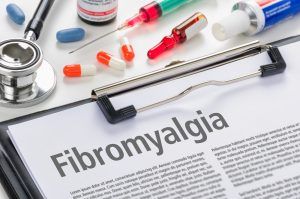Fibromyalgia is a chronic pain disorder that may be similar to arthritis, but it is not a type of arthritis. (Learn More) There is no known cause for the disorder. (Learn More)
Treatment for fibromyalgia should include a multidimensional approach. (Learn More) The first-line approach is the use of medications that are approved to treat fibromyalgia. (Learn More) Other medications can also be used as needed. (Learn More)
Behavioral interventions (Learn More) and lifestyle changes, such as dietary considerations, (Learn More) should also be implemented.
Overall, treatment for fibromyalgia should involve various treatment providers from different specialties (Learn More)
Fibromyalgia
Fibromyalgia is often classified as a type of rheumatic disease or an arthritic-like condition. Fibromyalgia is not a type of arthritis because there is no identifiable inflammation or damage to the joints or other tissues in most people diagnosed with it.
People with fibromyalgia often have issues with generalized and diffuse pain and sensitivity to pressure. The disorder is diagnosed based on 18 trigger points on the body that the physician assesses for sensitivity to pain and pressure.
People diagnosed with fibromyalgia complain of a litany of symptoms, many of which resemble various psychosomatic conditions.

What Is the Cause of Fibromyalgia?
There is no identified cause of fibromyalgia. According to the book
Fibromyalgia: Clinical Guidelines and Treatments, there are several risk factors that can increase the probability that someone may be diagnosed with the disorder, such as having a history of abuse, high levels of stress, and first-degree relatives who have been diagnosed with chronic pain.
The prevalence of the disorder worldwide is probably between 2 percent and 5 percent of all individuals. Females are diagnosed with fibromyalgia at a rate of 7:1 to males.
Treatment
Treatment for fibromyalgia often consists of medications, diet, exercise, behavioral interventions like psychotherapy, and other interventions.
The Centers for Disease Control and Prevention (CDC) suggests that the different modalities of treatment be combined in the overall treatment program. This includes medications, physical activity and physical therapy, and psychotherapy. There is a high rate of psychiatric issues in people diagnosed with fibromyalgia.
Medications Approved to Treat Fibromyalgia
There are three drugs approved by the Food and Drug Administration to treat fibromyalgia.
- Lyrica (pregabalin): This drug can treat epilepsy and pain by reducing the rates of neuronal firing.
- Cymbalta (duloxetine): This is an atypical antidepressant that works on serotonin and norepinephrine.
- Savella (milnacipran): This is another antidepressant that acts on serotonin and norepinephrine.
Research studies have found these drugs to be generally effective in reducing pain and discomfort associated with fibromyalgia. All these drugs require a prescription from a physician.
Other Medications
In addition to the approved medications to address fibromyalgia, other medications can also be used, often in conjunction with one of the above medications.
These can include over-the-counter pain relievers like nonsteroidal anti-inflammatory drugs, prescription pain medications like opioid drugs (tramadol), medications to assist with sleep, and drugs to address other symptoms, such as psychiatric symptoms. Depression and anxiety are often addressed with therapy and antidepressant medications.
Behavioral Interventions
A common treatment used for people who are diagnosed with fibromyalgia is cognitive behavioral therapy (CBT), a type of psychotherapy that can be used to address issues with chronic pain, depression, anxiety, and stress management.
Research has found that CBT can effectively help people with fibromyalgia control their pain, symptoms with depression, and other related issues. CBT has been shown to help patients become more functional.
Exercise — like physical therapy, yoga, walking, and weight training — can help people with fibromyalgia to improve their physical functioning. Complementary therapies that are used in addition to CBT and physical therapy can also be helpful, like massage therapy and mindfulness meditation.
Alterations in Diet
The use of an anti-inflammatory diet that discourages eating foods like nuts, fish, onions, raspberries, processed foods, and alcohol might reduce inflammation and therefore reduce the pain associated with fibromyalgia.
These types of diets may have some success in lessening pain and stiffness in individuals who have arthritis. Since fibromyalgia is considered to be an arthritic-like disorder, the use of a similar diet can potentially relieve some of the distress and pain associated with fibromyalgia.
Metabolic factors may play a part in the development of fibromyalgia. Altering diet to facilitate the functioning of the amino acid tryptophan, which is a precursor to serotonin, might also be useful.
In addition to the anti-inflammatory diet, these steps can be helpful:
- Limit sugar, including fruit.
- Avoid artificial sweeteners, particularly aspartame.
- Avoid foods that are high in monosodium glutamate.
- Avoid lactose (a protein found in milk products).
Any dietary changes should be discussed with a physician.

Putting It All Together
Successful treatment of fibromyalgia requires an approach that incorporates several different interventions, including medication, psychotherapy, physical therapy, and lifestyle changes. This typically requires a multidimensional team of treatment providers that includes physicians, psychologists or social workers, and other specialists like physical therapists and dietitians.
Many individuals with fibromyalgia are diagnosed with co-occurring psychological disorders, and these also need to be addressed.
There is no known cure for fibromyalgia. People diagnosed with the disorder need to create an environment that fits their needs. They will most likely need to experiment with different combinations of treatments to find what works for them.
References
Fibromyalgia. (August 2017). Mayo Clinic.
Fibromyalgia: Clinical Guidelines and Treatments. (2015). Springer.
Fibromyalgia. (October 2017. Centers for Disease Control and Prevention.
Living With Fibromyalgia, Drugs Approved to Manage Pain. (January 2014). Food and Drug Administration.
Internet Versus Face-to-Face Group Cognitive-Behavioral Therapy for Fibromyalgia: A Randomized Control Trial. (September 2015). Journal of Psychiatric Research.
Anti-Inflammatory Diet. Arthritis Foundation.



